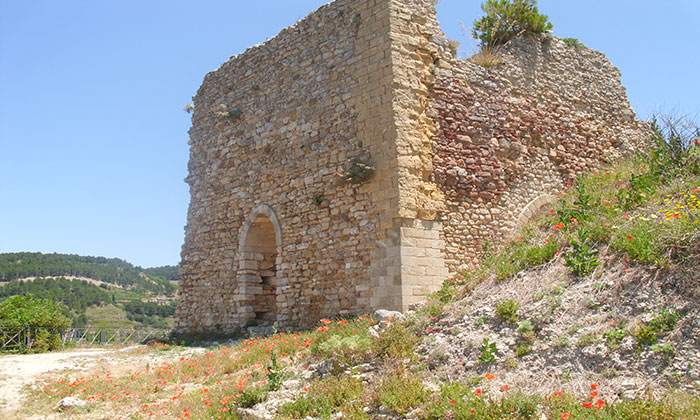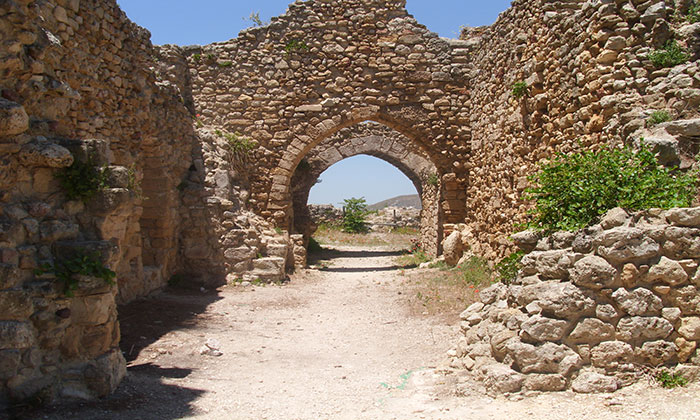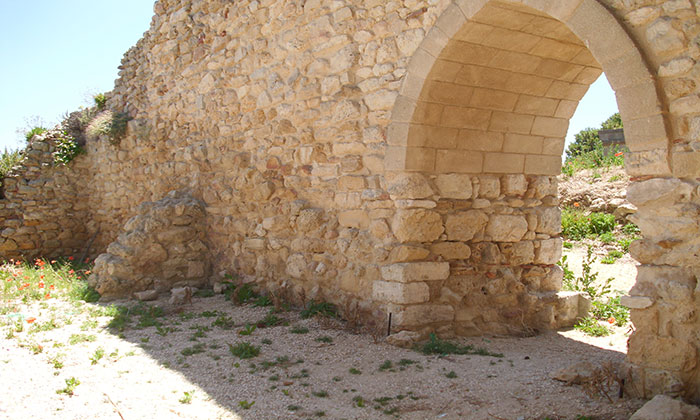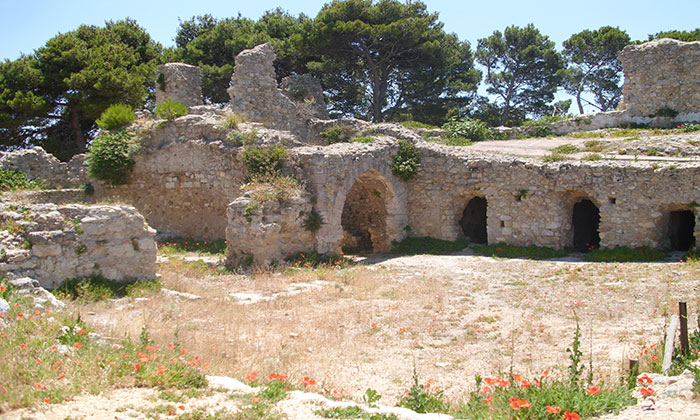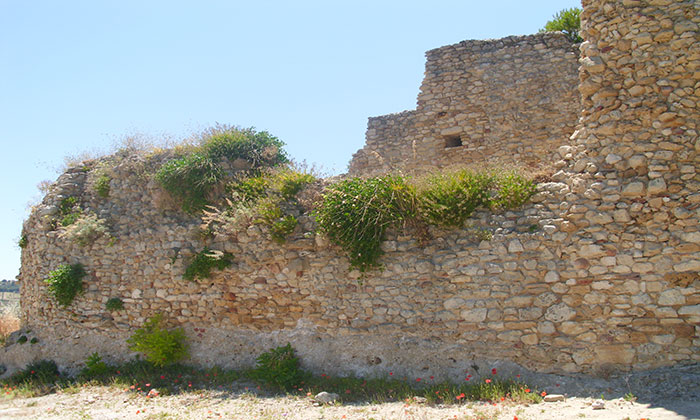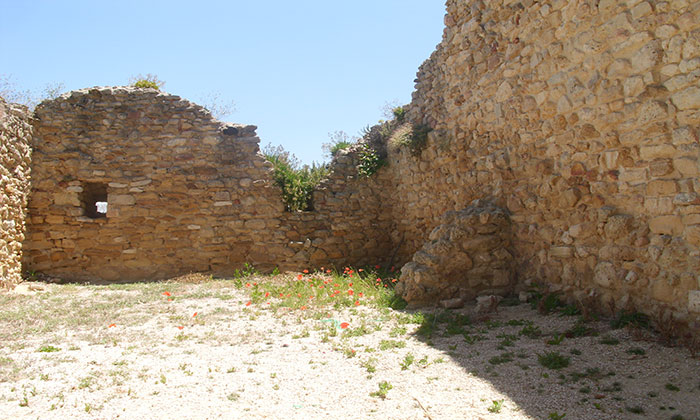Info Generiche
lat: 37°54’46.8″N
lng: 12°51’19.2″E
Itinerario Storia e Mito: 11°
CASTELLO EUFEMIO
Situato sul colle che sovrasta l’intero paese, è chiamato Eufemio o castello di Phimes. Questo castello dovette essere nella sua remota origine uno dei siti fortificati posti a difesa e a controllo delle vie di accesso a Segesta. Di esso si hanno documenti scritti solo a partire dalla metà del XII secolo, quando il viaggiatore e geografo arabo Edrisi lo descrive come un “castello antico primitivo” con un borgo popolato. Nella prima metà del XIII secolo è uno dei castelli imperiali utilizzati dalle truppe di Federico II nella lotta contro i musulmani, che sembra avessero il loro caposaldo nel vicino villaggio di Calatabarbaro in cima all’acropoli nord di Segesta. Fu poi il castello dei feudatari di Calatafimi e dei governatori che in alcuni periodi l’amministrarono per conto della Corona. Nel 1282, durante la rivolta del Vespro, in esso dimorava il suo feudatario, il provenzale Guglielmo Porcelet, che, amato dai suoi sudditi, fu risparmiato dai rivoltosi e rimandato incolume assieme ai familiari in Provenza. Fu poi presidio militare e prigione fino al 1868, anno nel quale venne abbandonato ed in cui iniziò il suo lento degrado. Delle tre torri di questo castello, raffigurato nello stemma del Comune, sopravvivono oggi solo i ruderi delle due torri collocate alle estremità nord e sud della facciata principale, che guarda verso il centro urbano. Nella cortina muraria che li univa, vicino alla torre sud, a sinistra di chi guarda volgendo le spalle all’abitato, si apriva la porta del castello. Della terza torre, che si ergeva sull’angolo sud-ovest, laddove si incontrano due grandi muraglioni a scarpata, non c’è più traccia. La porta immetteva in un vestibolo caratterizzato da due archi; da esso si accedeva alla corte. Sul lato sinistro del vestibolo e della corte si aprono le porte di alcune piccole celle sulle cui pareti si possono scorgere ancora i graffiti incisi dai detenuti. Sullo stesso lato delle celle si ergeva un altro piano che costituiva la residenza signorile. Su questo colle che ha una posizione strategica venne piazzata la maggior parte delle truppe borboniche dopo il loro arrivo a Calatafimi nella notte tra il 12 e il 13 maggio 1860. Queste truppe, comandate dal generale Francesco Landi, erano state inviate dal governo borbonico per fermare Garibaldi e i suoi Mille, sbarcati a Marsala l’11 Maggio 1860, nella loro avanzata su Palermo. A metà di questo colle, sul lato occidentale, a controllo della via di accesso al paese venne posizionato uno dei quattro cannoni di cui erano forniti i soldati borbonici.
EUFEMIO’S CASTLE
Located on the hill overlooking the whole country, it is called Eufemio or Phimes Castle. This castle had to be in its remote origin one of the fortified sites placed in defense and control of the access roads to Segesta. Of it we have written documents only since the mid-twelfth century, when the traveler and Arab geographer Edrisi describes it as a “primitive ancient castle” with a populated village. In the first half of the thirteenth century it is one of the imperial castles used by the troops of Frederick II in the fight against Muslims, who seem to have their stronghold in the nearby village of Calatabarbaro on top of the northern acropolis of Segesta. It was then the castle of the feudal lords of Calatafimi and the governors who in some periods administered it on behalf of the Crown. In 1282, during the revolt of the Vespers, his feudal lord lived in it, the Provençal Guglielmo Porcelet, who, loved by his subjects, was spared by the rebels and sent back unharmed along with his family in Provence. It was then military garrison and prison until 1868, the year in which it was abandoned and in which its slow degradation began. Of the three towers of this castle, depicted in the emblem of the Commune, only the ruins of the two towers at the north and south ends of the main facade survive today, looking towards the city center. In the wall that united them, near the south tower, to the left of the viewer, turning his back to the village, the door of the castle opened. Of the third tower, which stood on the southwest corner, where two large embankments meet, there is no trace. The door led into a vestibule characterized by two arches; from it it was entered to the court. On the left side of the vestibule and of the court are the doors of some small cells on whose walls you can still see the graffiti engraved by the inmates. On the same side of the cells there was another floor that constituted the noble residence. On this hill that has a strategic position was placed most of the Bourbon troops after their arrival in Calatafimi in the night between 12 and 13 May 1860. These troops, commanded by General Francesco Landi, had been sent by the Bourbon government to stop Garibaldi and his Thousand, landed in Marsala on May 11, 1860, in their advance on Palermo. In the middle of this hill, on the western side, one of the four cannons supplied by the Bourbon soldiers was placed in control of the access road to the village.
Château de Phimes
Situé sur la colline surplombant tout le pays, il s’appelle Eufemio ou Château de Phimes. Ce château devait être dans son origine lointaine l’un des sites fortifiés mis en place pour défendre et contrôler les voies d’accès à Segesta. Il n’a de documents que depuis le milieu du XIIe siècle, lorsque le voyageur et le géographe arabe Edrisi le décrivent comme un «ancien château primitif» avec un village peuplé. Dans la première moitié du XIIIe siècle, il est l’un des châteaux impériaux utilisés par les troupes de Frédéric II dans la lutte contre les musulmans, qui semblent avoir leur place forte dans le village voisin de Calatabarbaro au sommet de l’Acropole au nord de Segesta. C’était alors le château des seigneurs féodaux de Calatafimi et des gouverneurs qui l’administraient parfois au nom de la Couronne. En 1282, lors de la révolte des Vêpres, en ce qu’il a vécu son seigneur féodal, le Provençal Porcelet William, qui, aimé par ses sujets, a été épargné par les rebelles et renvoyés avec leurs indemnes membres de la famille en Provence. Il était alors une garnison militaire et une prison jusqu’en 1868, l’année où il a été abandonné et où sa lente dégradation a commencé. Sur les trois tours du château, représenté dans les armoiries de la ville, ne survivent que aujourd’hui les ruines des deux tours situées aux extrémités nord et sud de la façade principale, qui fait face au centre-ville. Dans la tenture qui les rejoignait, près de la tour sud, à gauche en regardant avec le dos vers l’entrée , la porte du château s’ouvrit. De la troisième tour, qui se trouvait sur le coin sud-ouest, où il y a deux grands remparts, il n’y a plus de trace. La porte dessine un vestibule comportant deux arches; par elle on accédé à la cour. Sur le côté gauche du vestibule et de la cour, vous ouvrez les portes de quelques petites cellules sur les murs desquelles vous pouvez encore voir les graffitis incités par les détenus. Du même côté de la cellule, il y avait un autre étage qui constituait la résidence majestueuse. Sur cette colline qui bénéficie d’un emplacement stratégique a été placé la plupart des troupes de Bourbon après leur arrivée à Calatafimi, dans la nuit entre le 12 et le 13 mai 1860. Ces troupes, commandées par le général Francesco Landi, avait été envoyé par le gouvernement de Bourbon pour arrêter Garibaldi et ses mille, arrivés à Marsala le 11 mai 1860, dans leur avance à Palerme. Dans la moitié de cette colline, sur le côté ouest, contrôlait la route d’accès au pays a été placé l’un des quatre canons fournis par les soldats Bourbon.

